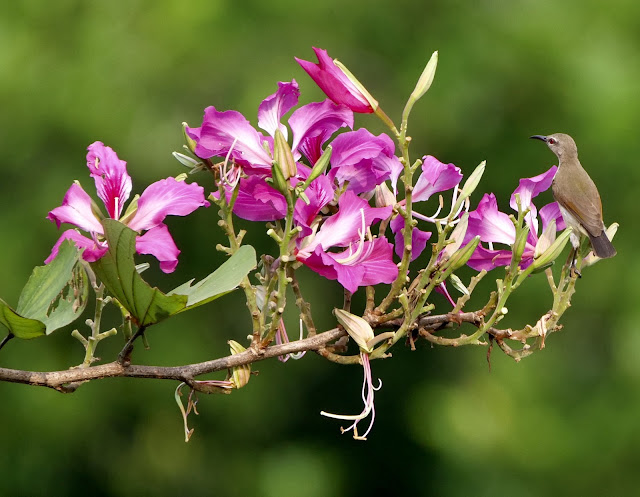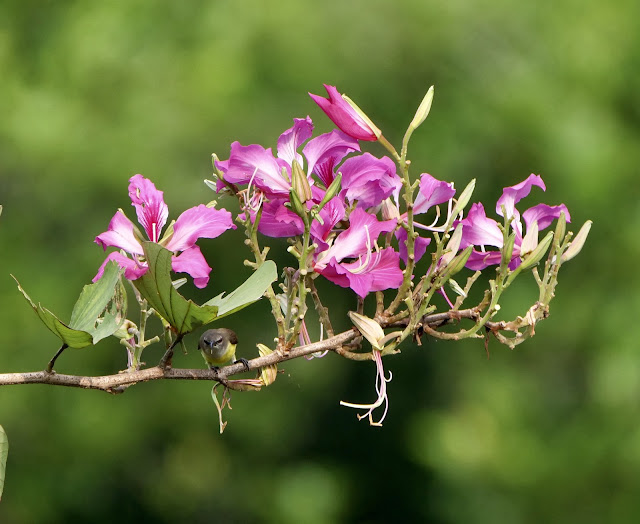
After noticing a Sunbird coming to this bunch of flowers for three days, around the same time in the morning, I positioned myself to capture its movements from arrival to departure.
I missed the first frame of arriving, but could get only after it positioned itself in the flower bunch. It moved gathering nectar, but stopped in between to look around. Its movements were swift and delightful to watch. The movements between flowers were so elegant that it did not even cause movements of the flowers in the process of gathering nectar.
I noticed that it flew away from the same place where it first arrived. The way it took off gave an impression of its highly co-ordinated body movements.
A small bird of about 10-15 gem length, neatly groomed with planned body movements is distinct from most other birds. One can almost miss sighting them unless one looks intently. They hide behind the foliage. They gather nectar swiftly and move away to the next target.
I noticed that when any chemical spray is used on the flowers to protect them from insects and caterpillars, the Sunbirds stop visiting the garden. Even bees disappear from the garden after spraying!
The up keep of a garden is in that sense difficult and needs careful planning.
In a telephonic conversation a few days back, one family mentioned to me how difficult it was to make the house child safe. Their three years old son is into all sorts of 'mischief'. The latest was using the kitchen knife and slicing the raw banana kept for ripening. As I listened to the family I understood that the child was in an exploratory pursuit. They did not plan activities for him, when one of the parents engaged him in creative play, outdoor activities or conversation time. Both parents having a demanding time at work place returned tired and just manage the household work. The child is in day care during most of the day.
He was left unattended. So he planned his activities on his own, most of which therefore were unwelcoming to parents. He even got punished for his 'mischiefs'.
The exploratory instinct of a three year old child is so compelling that a child is satisfied only after pursuing his or her impulsive interest without considering the consequences.
The orderly way a Sunbird gathered nectar came to me as an example of how a bird follows habits in a diligent way.
How do we create habits in pre-school children! This is possible when one of the parents engages the child in activities and explorations for the child to develop that as a practice even when he or she has to do it alone. I know of a family who practiced keeping back all the toys after the play time in the shelf that, it became a habit for their two year old son. He got used to the daily routines as one of the parents accompanied him to develop the different activities to make them as a ritual he could do himself.
The habit forming behaviours in pre-school children later would become rationally supported as they discover the reason behind doing things in a particular way.
A three year old boy would rush to the dining table to eat without washing his hands. His mother wiped his hand with a white wet kerchief and showed the dirt in the hand. After washing the hand with water with soap, she used the white kerchief to dry his hand. The boy was surprised to see how clean his hands had become. He associated that with the message that, it is with clean hands we are to eat.
The childhood habits would need rational support for a child to voluntarily to choose to practice good habits. Up until that time, it is the conditioning that creates the habit, for which instruction, correction and reinforcement would be needed.
I was impressed by the way a Sunbird moved about between flowers while gathering nectar. Its elegant movements came out of its habits and routines.
All good habits evolve by practice and conditioning in pre-school children !
M.C.Matherw(text and photo)







No comments:
Post a Comment